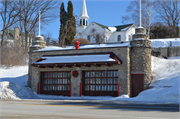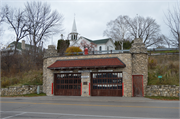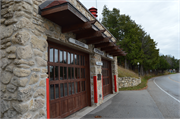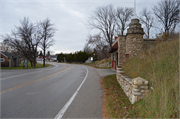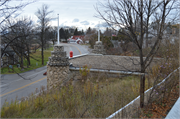| Additional Information: | A 'site file' exists for this property. It contains additional information such as correspondence, newspaper clippings, or historical information. It is a public record and may be viewed in person at the Wisconsin Historical Society, State Historic Preservation Office.
FACADE FLANKED BY ROUND STONE TOWERS W/STEPPED TURRETS. Mansard roof on facade, 2 towers, built into hillside.
Station functioned until 1990. "Improvements" over the years have distorted the symmetry of the original design. As of 2008, the building was being converted to a museum.
Resurveyed March 2014: subsequent changes include the replacement of the overhead garage bays, the replacement of the front door, and the replacement of the front awning.
2014- "This Arts and Crafts fire station was constructed in 1934 following a design by architect William Bernhard. It is rectangular in plan with limestone walls and a flat roof. The building is constructed into a hillside so that the rear elevation is below grade while the front (west) elevation is at grade. The façade contains two garage bays with restored overhead glass-paneled doors. Round towers are located at each of the front corners; a pedestrian door of board construction is located in the base of the southern tower. A hipped roof awning spans the wall above both garage bays.
The building’s interior was not accessible at the time of survey, but partial views were attained through the glazed garage doors. Based on this view, the interior consists of one large space with a concrete floor, stone walls, and a wood ceiling."
-"STH 42: Bluff Lane (Gibraltar) to Country Walk Dr (Sister Bay), WisDOT#4140-19-00, Prepared by Gail Klein, (2014).
2016- "Constructed in 1935 following a design by local architect William Bernhard, the Ephraim Engine House is a simplified representative of the Arts and Crafts style. It was built to house the fire engines and volunteer fire fighting force of Ephraim. The property consists of a rectangular building with a flat graveled roof and is constructed into the hillside so that the front elevation on Water Street is at grade, while the rear elevation is below grade. Constructed with local limestone rubble, the integrity of the building is high. The building's distinctive features include a bracketed awning and stepped stone towers at the western corners.
West (front) elevation
The front elevation of the Engine House is symmetrical in plan, with two overhead garage doors containing three rows of glass panes above one row of wooden panels. These doors, representative of the doors originally present on the building, were added to the building during the 2008 restoration. Above the doors is a shingled hipped awning, supported by wooden brackets that mimic exposed rafter ends. This awning was also added to the building in 2008 and is based on original designs. On either side of the overhead doors, set back slightly from the front elevation, are round stone towers topped with stepped turrets and a flagpole at the top of each tower. The base of the southern tower contains a vertical board pedestrian door that opens into the interior. This door replaced a metal door that was added to the building prior to 1990. Centered above the awning is a metal fire siren, possibly original. A series of wooden signs over the garage doors on the west facade advertise the building's historic and current uses ("Ephraim -Volunteer-Fire Department- Museum"). Stepped stone retaining walls, constructed of coursed limestone rubble, are attached to the stone towers on each side. The walls arch away from the building, traveling north and south on Water Street for approximately 30 feet in each direction.
Side and rear elevations
The north and south elevations are partially buried within the hillside. The sides of the stone towers are visible, as are a part of the flat roof. Visible portions are constructed with the same random limestone rubble as the western facade. Just visible behind the stepped towers is a slab of limestone with a course of squared stones on top, forming a subtle cornice on the north and south elevations. This cornice disappears completely into the hillside. The rear of the building is completely submerged in the hillside and no part of the exterior elevation is visible.
Interior
The interior of the Engine House consists of a single large room with unfinished stone walls, a concrete floor covered by metal tiles, and a drop ceiling with pendant lights. Interior stone walls appear to be more uniformly coursed than the exterior. The stone towers at the southwest and northwest corners are hollow -the southern tower holds the pedestrian doorway and the northern tower contains general storage. In addition to the pedestrian doorway, the interior is also accessible via two overhead garage doors on the west wall. Several sections of the stone wall appear to have been recently replaced or repainted, likely due to water damage. The presence of water seepage is apparent throughout the interior, in particular on the rear (east) wall of the room, which reportedly holds a water cistern behind it. The Engine House is currently a museum for the Village of Ephraim's Fire Department. The museum holds two vintage fire engines and various firefighter paraphernalia. It is open for viewing during the summer tourist season.
Historic Context
First explored by French fur traders and explorers as early as the 1600s, permanent white settlement of Door County began in the 1840s in the Sturgeon Bay area. The county was first organized in 1851 as part of Manitowoc County, and was later separated from Manitowoc in 1855 and reorganized. The Village of Ephraim was founded as a Moravian religious community in 1853. Led by Reverend A.M. Iverson, a group of Norwegian Moravians traveled from the Green Bay area and began clearing land and building houses at the edge of a natural harbor in Door County, later named Ephraim. Subsistence farming and fishing were the main economic pursuits in early years of the settlement, and eventually fruit trees were found to be particularly successful in Door County soils. The area's natural beauty had long attracted visitors to the peninsula; however, poor roads and lack of rail access made visiting difficult. That changed with the arrival of the Goodrich Shipping Line in 1888, which made Ephraim a regular port of call and opened the door to trade, travel, and tourists. Improvement of the roads began in 1905, further increasing access to the area. The rise of the tourism industry brought new prosperity to Ephraim, with multiple hotels in existence by the early 20th century. Ephraim was organized as a village in 1919. Although tourism was (and remains) a seasonal economic base for the region, many of the visitors to Ephraim have made a lasting impact on the village. Architect William Bernhard, for example, eventually moved permanently from Chicago to Ephraim, and is responsible for designing many distinctive homes in the area, as well as Ephraim's Village Hall.
In the 1930s, the Great Depression affected Ephraim's economy along with the rest of the country, and Door County relied on federal relief programs to carry on with its projects, as it did not have the tax revenue necessary to conduct business on its own. 8 One of the federally funded programs intended to provide relief and work to the nation's unemployed was the Federal Emergency Relief Act (FERA). The program was created in 1933 as part of President Roosevelt's New Deal to work with state and local governments, providing grant money for a variety of jobs and projects in the arts, construction, and educational fields. In Door County, many projects qualified for federal relief money, including work on local schools and community halls, grounds keeping, and road maintenance. In this way, Door County was able to provide some economic relief for its residents during the Great Depression and could continue government services and construction. Today, Ephraim relies on the summer tourist industry as its economic mainstay. Some of the Village's Depression-era relief projects, such as the trails and buildings in Peninsula State Park and the Ephraim Engine House, are still extant and enjoyed by all.
Property History
The Ephraim Engine House was constructed of local limestone in 1935 following a design by prominent local architect William Bernhard. Construction of the building relied on funds provided by FERA. As such, although Bernhard drew the plans for the structure in 1934, construction did not begin until April of 1935, when FERA funds became available. Once construction began, it was likely carried out by local workmen, as the CCC camp in nearby Peninsula State Park was not established until August of that year. Original plans for the building called for curving stone stairs on either side of the stone towers, leading up to a planned overlook toward the harbor on the roof of the building. In addition, there was also space planned for a drill room at the rear of the garage area. These elements were not included in the final construction. As a result, the building lacks some of the architectural details that would have increased the charm of the structure but had no positive effect on its utility. These changes likely reflect the need for economy when building with relief funds. The hillside into which the station was built was heavily excavated for construction, and as a result of poor drainage, the building has always suffered from seasonal water damage.
Upon completion of the Engine House in 1935, Ephraim purchased the first motorized fire truck in Door County, which is still housed at the Engine House today. The building served as the home of Ephraim's volunteer fire department from 1935 to 1990. 15 Over time, the Engine House was updated and altered, with the replacement of its original doors with metal overhead garage doors. A shingled awning that spanned almost the entire width of the facade was also added, along with a short vertical board cornice above that contained the building's signage. After 1990, a new fire station was built for the village and the Engine House was used for storage. In 2008, funds were collected from Village residents to restore the building to its original appearance. Insensitive alterations were removed and replaced with period-appropriate ones, including glass paneled overhead garage doors, and a smaller shingled awning supported by carved brackets. Bernhard's original architectural plans and rendered drawings were used to restore the building as faithfully as possible to its original appearance, although the "extras," like the curving stone stairs Bernhard had planned but never executed, were not included. 16 It is also clear that portions of the stone exterior and interior have been re-painted or re-laid, possibly following water damage. The Engine House now serves as a museum for the fire department in Ephraim, and is open to the public during the summer tourist season."
-"Ephraim Engine House", WisDOT#4140-19-00, Prepared by UWM-CRM (Kelly Noack), (2016). |
|---|

